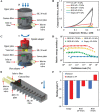Pump Up the Jam: Granular Media as a Quasi-Hydraulic Fluid for Independent Control Over Isometric and Isotonic Actuation
- PMID: 35343110
- PMCID: PMC9131430
- DOI: 10.1002/advs.202104402
Pump Up the Jam: Granular Media as a Quasi-Hydraulic Fluid for Independent Control Over Isometric and Isotonic Actuation
Abstract
Elastomer-granule composites have been used to switch between soft and stiff states by applying negative pressure differentials that cause the membrane to squeeze the internal grains, inducing dilation and jamming. Applications of this phenomenon have ranged from universal gripping to adaptive mobility. Previously, the combination of this jamming phenomenon with the ability to transport grains across multiple soft actuators for shape morphing has not yet been demonstrated. In this paper, the authors demonstrate the use of hollow glass spheres as granular media that functions as a jammable "quasi-hydraulic" fluid in a fluidic elastomeric actuator that better mimics a key featur of animal musculature: independent control over i) isotonic actuation for motion; and ii) isometric actuation for stiffening without shape change. To best implement the quasi-hydraulic fluid, the authors design and build a fluidic device. Leveraging this combination of physical properties creates a new option for fluidic actuation that allows higher specific stiffness actuators using lower volumetric flow rates in addition to independent control over shape and stiffness. These features are showcased in a robotic catcher's mitt by stiffening the fluid in the glove's open configuration for catching, unjamming the media, then pumping additional fluid to the mitt to inflate and grasp.
Keywords: fluidic elastomer actuators; granular flow; granular jamming; soft robotics; variable stiffness.
© 2022 The Authors. Advanced Science published by Wiley-VCH GmbH.
Conflict of interest statement
The authors declare no conflict of interest.
Figures




References
-
- Vogel S., Comparative Biomechanics: Life's Physical World, Vol. 2, Princeton University Press, Princeton, NJ: 2003.
-
- Nishikawa K., Biewener A. A., Aerts P., Ahn A. N., Chiel H. J., Daniel T. L., Full R. J., Hale M. E., Hedrick T. L., Lappin A. K., Nichols T. R., Quinn R. D., Satterlie R. A., Szymik B., Integr. Comp. Biol. 2007, 47, 16. - PubMed
-
- Rus D., Tolley M. T., Nature 2015, 521, 467. - PubMed
-
- Ilievski F., Mazzeo A. D., Shepherd R. F., Chen X., Whitesides G. M., Angew. Chem. 2011, 123, 1930. - PubMed
-
- Whitesides G. M., Angew. Chem., Int. Ed. 2018, 574, 4258. - PubMed
Publication types
MeSH terms
Substances
Grants and funding
LinkOut - more resources
Full Text Sources
